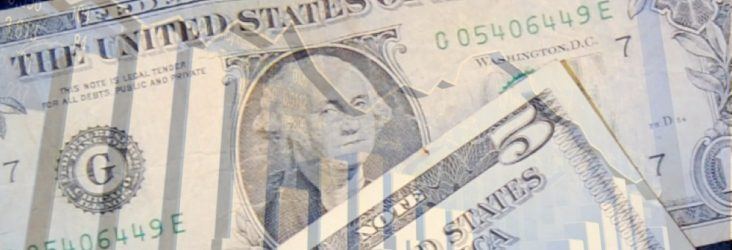U.S. GDP growth holds steady in fourth quarter at 2.5%
by March 1, 2018 11:21 am 333 views

The nation’s general economic picture held steady in the fourth quarter of 2017 as strong consumer spending, fixed investments and government outlays picked up in the months heading into the Christmas holiday season, according to the second estimate of the nation’s Gross Domestic Product report released Wednesday (Feb. 26) by the Bureau of Economic Analysis (BEA).
The final quarterly spotlight on U.S. economic growth in 2017 will be released on March 28. The revised “second” estimate of 2.5% GDP growth in the three month period ended Dec. 31 is moderately one-tenth of a percentage point below the first estimate released by the BEA on Jan. 26.
Still, the revised 2.5% output for the U.S. GDP growth matched Wall Street consensus forecasts for the final quarter of 2017, and will set the U.S. economy on target to close out the first year of President Donald Trump’s administration with annual growth of 2.5%, compared to a tepid 1.85% expansion in 2016.
The fourth quarter GDP tally, however, is well behind the economy’s total output of goods and services in the second and third quarters of 2017, which grew at a rate of 3.1% and 3.2%, respectively. A year ago, President Obama closed out the final quarter of his administration with GDP growth of 1.8%.
Wednesday’s GDP was released ahead of newly appointed Federal Reserve Chair Jerome Powell’s first monetary policy address to Congress. Powell was picked by President Donald Trump in late 2017 to replace Janet Yellen, the first woman to serve as the nation’s chief monetary policymaker.
In his economic outlook pitch to the U.S. House Committee on Financial Services, Powell offered an upbeat assessment of the nation’s economy. Citing solid job growth, moderate wage pickup and a slowing housing market, the new Fed chairman said inflation-adjusted GDP growth advanced at an annual rate of about 3% in the second half of 2017.
“Against this backdrop of solid growth and a strong labor market, inflation has been low and stable. In fact, inflation has continued to run below the 2% rate that the Federal Open Market Committee (FOMC) judges to be most consistent over the longer run with our congressional mandate,” Powell testified on Wednesday.
INTEREST RATE MOVES
Powell said the FOMC has continued to gradually reduce the accommodation monetary policy adopted during Yellen’s helm, specifically citing the Central Bank’s decision to raise the target range for the federal funds rate by a 1/4th of a percentage point at the December meeting.
“Specifically, we raised the target range for the federal funds rate … by bringing the target to a range of 1.25% to 1.5%. In addition, in October we initiated a balance sheet normalization program to gradually reduce the Federal Reserve’s securities holdings. That program has been proceeding smoothly,” Powell said.
Powell, who is not a trained economist, said the interest rate and balance sheet actions reflect the FOMC’s view that gradually reducing monetary policy accommodation will sustain a strong labor market while fostering a return of inflation to 2%.
Powell said he is gauging the appropriate path for monetary policy over the next few years, adding that the FOMC will continue to “strike a balance” between avoiding overheating the U.S. economy and bringing personal consumer spending inflation to 2% on a sustained basis.
Under that policy, American Banking Association (ABA) Chief Economist James Chessen and other top economic forecasters expect the Fed to take action again in March to raise interest rates. Like most of Wall Street, ABA expects the Powell-led FOMC to hike interest rates at least three times in 2018, “something banks are well prepared to manage and have included in their asset and liability management plans,” Chessen said.
“With nearly $2 trillion in capital, banks remain the safest place to put your money – as demonstrated by a solid 4% growth in new deposits,” Chessen noted after Powell’s appearance for the House committee. “Interest rate risk is always top of mind for banks, particularly with the Fed likely to take action again in March to raise rates.”
SLOWER GDP GROWTH PREDICTED
Most Wall Street economists are forecasting annual GDP growth of less than 3.5% in 2018. However, Wall Street financial powerhouse Goldman Sachs and the Atlanta GDPNow have steadily downgraded the nation’s GDP growth in the first quarter of 2018.
Goldman Sachs economists have increasingly raised concerns in recent weeks about U.S. deficit spending approaching “uncharted territory,” highlighted by the Trump administration’s $1.5 trillion tax cut package approved by Congress in December.
Atlanta GDPNow estimated on Wednesday that real GDP growth in the first quarter of 2018 will slide to 2.6%, down from the previous estimate of 3.2% a week earlier. The downgrade by the economic forecasting group housed in the Sixth Federal Reserve Bank District was the result of weaker fixed investment spending by U.S. manufacturers and national housing market reports showing that first-quarter residential spending has decline from -0.6% to -4.5% over the last week.
